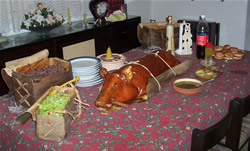Cuban Christmas
- Submitted by: admin
- Editorial Articles
- Culture and Traditions
- History
- Politics and Government
- 05 / 28 / 2007

When the revolution triumphed and as part of the disagreements between the new government and the church, Christmas time like any other religious event was victim of a complete amnesia by the authorities. Even, ten years later was officially prohibited the celebration of Christmas and claimed that the measure was taken to prevent people to distract their attention from the work in the sugar cane harvest which were the most important for them.
For almost four decades December 25 was like any other day, excepting for a small group of people that always kept their religious practice, some more public than others. In this period, that celebration was only a party for a minority that celebrated discreetly in their church or their house and even with the doors closed.
In 1997 just before the visit of Pope John Paul II to Cuba, being a transcendental surprise for all Cubans in and out of the island, and without giving any explanation, the revolutionary government declared that day as a holiday to allow the workers rest and enjoy it. This was officially established from that year on.
Then, the Christmas symbols began to appear again in Cuba. Even, at a public level, in shops in their shop windows and in the rest of the facility. Christmas trees began to be sold as well as all the typical accessories of that significant date.
In the religious world, an avalanche of people came to the different churches that took midnight mass celebration up again and that became the most popular Christian practice of the island. Main figures of the government headed by President Fidel Castro attended that celebrated at the Havana Cathedral.
From that moment on, Christmas has been incorporated traditionally to the Cuban family as something normal.
Regarding the culinary traditions that characterize the Cuban Christmas, they answer to a culture inherited from the time of conquerors to the conditions of the country. The Spanish conquerors introduced the pig raising in Cuba therefore, the traditional turkey of the Christmas Eve has been replaced by pork or any other meat.
The pig, pork or macho asado whatever is called, is the main character of the culinary scene of the Cuban Christmas. In the cities with a small housing space it is used by genera rule, the legs and in the smallest towns and in rural areas where there are proper conditions for raising this animal, they kill and cook them. They make chops from the back, the delicious pork scratchings obtained when the skin is fried or the tasty fried meat.
In those places where the animal is sacrificed the steps for is proper preparations are followed, it is a completely party day. Neighbors, friends or relatives meet, they dance and play dominoes, drink rum and talk about their lives. In the great cities, people try to follow this tradition.
The desserts are other hallmark of the Christmas table, turrones which are candies traditionally eaten at Christmas, of different origins, from those bought in shops like yolk, alicante,jijona, fruits and others to those from the homemade production made of coconut, guava, sweet potato, Chinese pumpkin etc.
The most traditional ones are the famous buñuelos (fritters) made of viands and flour fried and served with syrup or together with any of the aforementioned homemade desserts.
Generally, although the versions can be different, according to the style, the inspiration is always the deepest emotion of the human being the day before the birthday of Jesus.
Comments